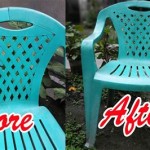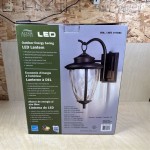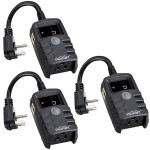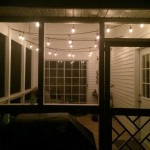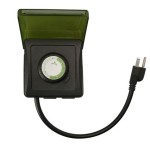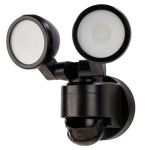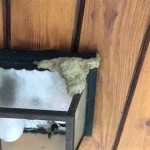Troubleshooting an Outdoor Security Light That Fails to Illuminate
Outdoor security lights provide a crucial layer of protection and safety for residential and commercial properties. These lights deter potential intruders, illuminate pathways, and enhance visibility during nighttime hours. When a security light malfunctions and fails to turn on, it compromises security, creates hazardous conditions, and can cause unnecessary concern. Identifying the root cause of the problem is the first step in restoring the functionality of the light and ensuring continued protection.
A systematic approach to troubleshooting is essential to pinpoint the issue. This involves examining various components, from the power source to the light fixture itself. Careful inspection and testing will help determine whether the problem lies in a simple malfunction or a more complex electrical issue. Before attempting any repairs, it's imperative to prioritize safety by disconnecting the power supply to the light fixture. This minimizes the risk of electrical shock or further damage to the system.
This article will delve into the common reasons why an outdoor security light might fail to illuminate and provide a practical guide for troubleshooting the problem. Furthermore, it will address potential solutions for resolving these issues.
Power Source Verification
The first step in diagnosing a non-functional outdoor security light is to verify the integrity of the power source. Without a reliable power supply, the light will undoubtedly fail to operate. This involves checking both the circuit breaker and the electrical outlet or wiring connected to the security light.
Begin by inspecting the circuit breaker associated with the outdoor lighting circuit. Locate the electrical panel and identify the breaker labeled "Outdoor Lights" or a similar designation. Ensure that the breaker is in the "ON" position. If the breaker is tripped (in the "OFF" or a middle position), reset it by switching it to the "OFF" position and then back to the "ON" position. If the breaker trips immediately upon resetting, it indicates a potential short circuit in the wiring or a fault within the light fixture itself. In this scenario, further investigation by a qualified electrician is necessary.
If the circuit breaker is functioning correctly, the next step is to examine the electrical outlet or wiring connection to the security light. For lights plugged into an outdoor outlet, test the outlet using a multimeter or a known working device, such as a lamp. If the outlet is not providing power, the issue may lie with the outlet itself or the wiring leading to it. Replacement of the outlet may be necessary. If the light is hardwired, carefully inspect the wiring connections within the junction box. Look for loose wires, corroded terminals, or damaged insulation. Tighten any loose connections and replace any damaged wiring. Remember to disconnect the power at the breaker before working with any electrical wiring.
In some cases, the issue could be a faulty photocell or timer that controls the light. These devices regulate when the light turns on and off based on ambient light levels or a pre-set schedule. If the photocell is defective, it may prevent the light from turning on even when it's dark. To test the photocell, temporarily bypass it by directly connecting the wires that lead to the light fixture. If the light turns on, the photocell is the likely culprit and needs replacement. Similarly, if the timer is malfunctioning, it may not be sending power to the light at the scheduled time. Consult the timer's instruction manual for troubleshooting steps or consider replacing the timer.
Light Fixture and Bulb Inspection
Once the power source has been verified, the next step is to thoroughly inspect the light fixture and the bulb itself. A faulty bulb or a damaged fixture can prevent the light from functioning properly. A visual inspection should be the first stage of this process.
Begin by examining the bulb. Check for any signs of damage, such as cracks, breaks, or blackening. If the bulb appears to be damaged, replace it with a new bulb of the correct type and wattage. Ensure that the new bulb is properly installed and secured within the fixture. Even if the bulb appears to be intact, it may still be defective. To test the bulb, try it in another working light fixture. If the bulb fails to illuminate in the working fixture, it confirms that the bulb is faulty and needs replacement.
If the bulb is functional, the next step is to inspect the light fixture itself. Look for any signs of damage, such as cracks, breaks, or corrosion. Check the wiring connections within the fixture to ensure that they are secure and free from corrosion. Loose connections can prevent the flow of electricity to the bulb. Use a wire brush to clean any corroded terminals or connections. If the fixture is severely damaged or corroded, it may need to be replaced.
Another potential issue could be a faulty socket. The socket is the component that holds the bulb and provides the electrical connection. Over time, sockets can become corroded or damaged, preventing the bulb from making proper contact. To test the socket, use a multimeter to check for continuity between the socket terminals. If there is no continuity, the socket is likely faulty and needs to be replaced. Replacing a socket typically involves disconnecting the power to the fixture, removing the old socket, and wiring in the new socket. Ensure that the new socket is compatible with the type of bulb being used.
In some cases, the issue could be a faulty capacitor within the light fixture. Capacitors are commonly found in LED and fluorescent lights and are used to store and regulate electrical energy. If the capacitor fails, it can prevent the light from turning on. Identifying a faulty capacitor can be challenging, but common symptoms include flickering, dimming, or a complete failure to illuminate. If you suspect a faulty capacitor, it's best to consult with a qualified electrician for diagnosis and repair.
Motion Sensor Malfunction
Many outdoor security lights are equipped with motion sensors that trigger the light to turn on when movement is detected within a certain range. If the motion sensor is malfunctioning, it can prevent the light from turning on even when there is activity nearby. Troubleshooting the motion sensor functionality is a critical step in identifying the source of the problem.
Begin by checking the sensitivity settings of the motion sensor. Most motion sensors have adjustable sensitivity controls that allow you to customize the detection range. Ensure that the sensitivity is set to an appropriate level. If the sensitivity is set too low, the sensor may not detect movement effectively. Conversely, if the sensitivity is set too high, the sensor may be triggered by unwanted sources, such as wind or small animals. Experiment with different sensitivity settings to find the optimal level for your environment.
Another potential issue is the detection range of the motion sensor. Verify that the sensor is positioned in a location that provides adequate coverage of the desired area. Obstructions such as trees, bushes, or walls can block the sensor's field of view and prevent it from detecting movement. If necessary, relocate the sensor to a more suitable location. Ensure the sensor's lens is clean and free of debris. Dirt, dust, or cobwebs can interfere with the sensor's ability to detect movement. Clean the lens with a soft cloth.
The "on-time" setting determines how long the light stays on after motion is detected. Check the timer setting to ensure that the light is set to stay on for a sufficient duration. If the on-time is set too short, the light may turn off too quickly, making it appear as though the sensor is not working properly. Increase the on-time setting to allow the light to remain on for a longer period.
Some motion sensors have a test mode that allows you to verify their functionality. Activate the test mode and observe the sensor's response to movement. If the sensor does not respond to movement in test mode, it indicates a potential malfunction. In this case, consider resetting the sensor by disconnecting the power and then reconnecting it. This can sometimes resolve minor glitches. If the sensor continues to malfunction after resetting, it may need to be replaced.
Interference from other electronic devices can also affect the performance of the motion sensor. Sources of interference include radio transmitters, wireless devices, and other electronic equipment. Try moving these devices away from the motion sensor to see if it resolves the issue. In some cases, a faulty motion sensor may be the cause of the problem. If all other troubleshooting steps have been exhausted, consider replacing the motion sensor with a new unit.
Addressing a non-functioning outdoor security light requires a thorough evaluation of the power source, the light fixture, the bulb, and the motion sensor. By systematically inspecting each component and following the troubleshooting steps outlined above, it is possible to diagnose and resolve most common issues. However, it is crucial to prioritize safety and consult a qualified electrician if you are uncomfortable working with electrical wiring or if the problem appears to be complex.

How To Fix Motion Sensor Security Floodlight Not Working

How To Reset A Motion Sensor Light Lighting And Ceiling Fans The Home Depot

How To Troubleshoot Motion Detector Lights Solutions For Every Problem

How To Make A Motion Sensor Light Stay On Rayzeek
My Outdoor Security Light Won T Turn Off George Brazil Plumbing Electrical

Phl Sil 5k Brushed Chrome Led Floodlight Satin 2 Light With Sensor Cool White N Lighting

Phl4202 Wht 3k Brushed Chrome Led Floodlight Satin 2 Light With Sensor Cool White N Lighting

Motion Sensor Outdoor Lights Battery Powered Waterproof Operated 6000k Led Spot Light Security For Outside Garage And Yard Not Included Temu

Outdoor Light With Decorative Not A Flood Connected Things Smartthings Community

Benefits Security Lights Advance Maintenance Ltd
Related Posts
